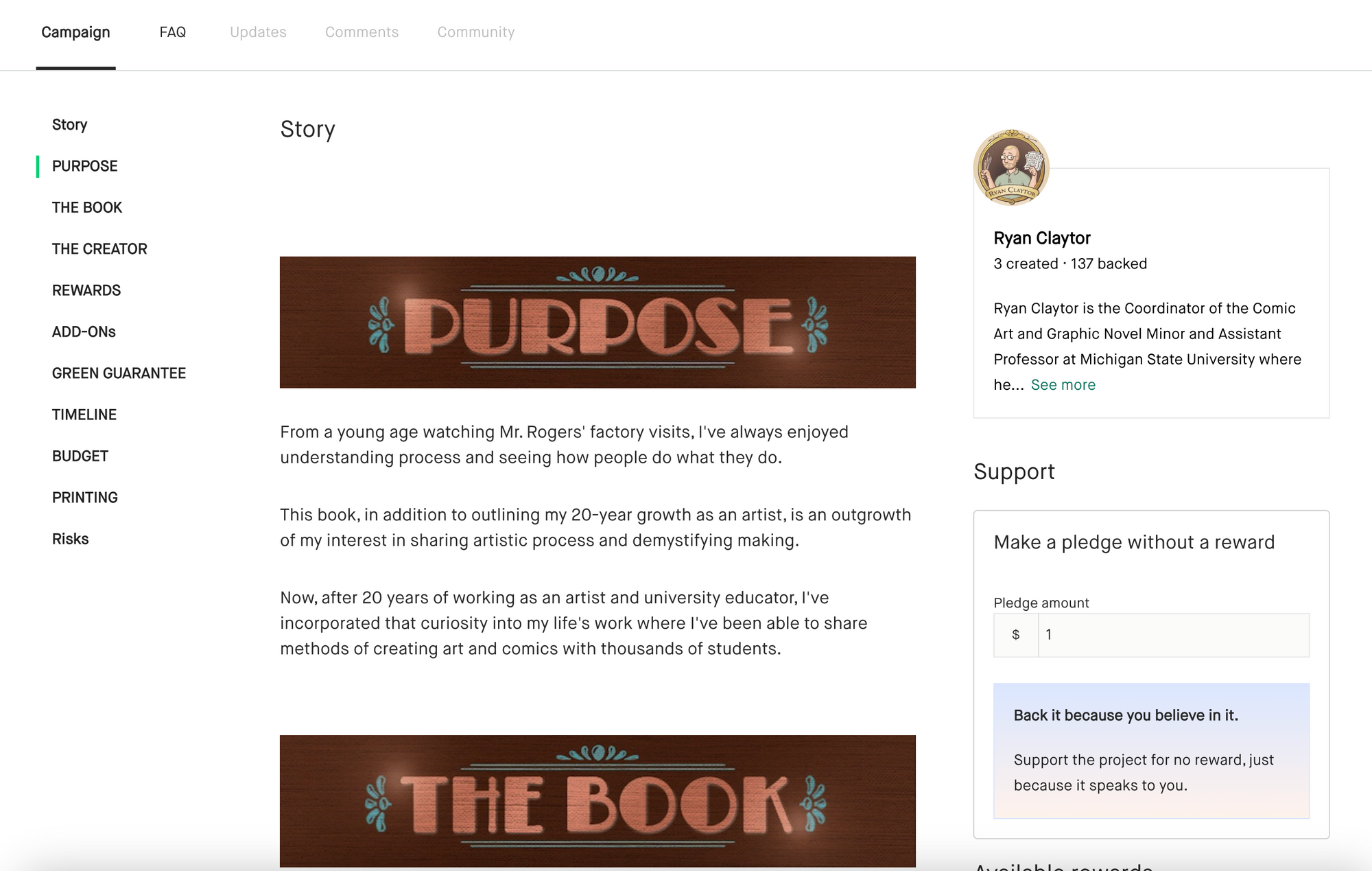10 Ways To Level Up Your Campaign Page
Are you a Creator looking to attract backers and enhance your project's story? This is the blueprint you need.

A Kickstarter project campaign page may appear simple, but it is a blank canvas for a tremendous amount of variation, creativity, and storytelling. Whether you are a first-time creator or a crowdfunding vet, in this blog post, we will review 10 essential elements that comprise a successful campaign page — including the title and subtitle, project image, project videos, funding goal, campaign length, storytelling, backer rewards, and risks and challenges.
Additionally, we will introduce you to some of our new product features, such as the revamped Text Editor and Images as Headers update, which will help you create a dynamic and visually stunning campaign page. By focusing on each of the key elements, you will bring every aspect of your campaign to life for your community of backers.
1. Choosing the Right Title and Subtitle for Your Work
Kickstarter allows up to 60 characters for your project title and 135 for your subtitle, which is more than enough space if you use them wisely. A well-crafted title and subtitle can tell a complete story with just a few words, providing specific and contextual information that piques the interest of potential backers, fans, and community members. They should also be easily shareable on social media, allowing your audience to help spread the word about your project with a single glance. Successful Kickstarter campaigns are often those that inspire a wide range of people to share them, so it's important to make your project easy to understand and appealing to your target audience. By crafting a concise, compelling title and subtitle, you can generate interest and excitement, and help your project stand out in a crowded marketplace.
2: Selecting Project Images
The image you select to showcase your project plays a vital role in telling a comprehensive story about it. Since this image will always appear next to your project’s title and subtitle, it should be able to convey the necessary information in a single image without requiring text on top of it. Therefore, make sure the image is not too busy or overloaded with small text.
A cluttered image will be impossible to read or parse when rendered thumbnail-sized, like in a social post or on a search page. If you want to share your progress visually during your campaign, Kickstarter has created various badges such as "just launched" and "nearly funded" that anyone can use. This helps you without cluttering your project image. You can also design your badges, but make sure you do not overload your image with "sales"-y overlays that will distract people from the creative nature of your work.
3. Creating an Engaging Video
While not compulsory, a project video can help attract backers and showcase your work. Keep it short and engaging, as backers tend to drop off after the first minute. Use basic editing tools and a phone or laptop camera, and maintain an upbeat tone. Adding subtitles and captions will improve accessibility. You can also generate other content, like short clips and gifs, to supplement the project video and share with your backers during the campaign.
4. Our Revamped Text Editor
We have made significant improvements to our text editor, which now includes storytelling tools that make editing easier and more intuitive. With media embedding options for videos and songs, and page anchors for table of contents, you can now create engaging content effortlessly. Additionally, a contextual toolbar has been added, which changes based on the content you're editing. For example, if you click on an image, you can quickly add captions, URLs, and alt text. One of the most requested features by project creators and backers was a simple way to navigate through project stories. We have addressed this by adding a table of contents functionality, allowing for quicker and easier navigation through lengthy project stories with images, long paragraphs, and updates.
5. Leveraging Images as Headers for Easier Project Navigation
When you create a campaign page for your project, you have the opportunity to unleash your creativity. You can choose to add simple text headers or incorporate custom graphics or images, as long as your backers can easily navigate the page. To facilitate this, we have continued to innovate our text editor tool, giving you the freedom to create your campaign page just the way you want it. There is no one-size-fits-all approach to creating a campaign page or marketing your ideas. As a creator, you should feel free to tell your story in your own unique way. You can use images as headers to create a stunning page for your project while providing backers with all the necessary information.

6. The Art of Campaign Storytelling
Our Creator Handbook offers valuable advice on how to communicate effectively about your project but here are some additional tips to keep in mind:
- Start with a brief summary sentence or paragraph to give potential backers a clear understanding of your project. Avoid lengthy introductions that can cause people to lose interest quickly and keep in mind that when viewed on a cell phone, only the top part of your campaign will be visible at a glance, so make sure you utilize that section well.
- Be sure to complete your creator profile by adding links to your website and social media accounts, and include them in your campaign story. This is also important for all collaborators and contributors so backers can find and follow them easily.
- Remember that the internet is a visual medium, so it's important to include plenty of images and photos to break up your text. If you don't have enough visuals, you can use graphic headers, bulleted lists, and other textual elements to make the page more dynamic.
7. The Magic of Rewards
Our creator handbook provides an overview of rewards, and our Kickstarter Project Update blog has plenty more tips on how to use imagery to effectively communicate these rare and exclusive rewards. It's up to you to decide how many different tiers to include, but make sure to come up with special rewards that won't be onerous for you to produce and ship. Use our worksheet to plan out pricing for common reward items. Finally, stay informed about supply chain disruptions and shipping issues, and make sure to build in buffer time when estimating delivery dates.
8. Explaining Risk & Challenges
Launching a Kickstarter campaign can be both exciting and daunting, especially for first-time creators. To establish trust with our backers, it's important to clearly outline the potential risks and challenges associated with fulfilling the project once the campaign has been successfully funded. This includes careful planning and preparation to ensure that the project is completed successfully and on time.
- Plan a realistic timeline and budget and calculate your expenses accurately. Include production costs, shipping, marketing, and be prepared for unexpected costs by having a buffer.
- Be transparent about potential challenges. Let backers know about risks and how you plan to overcome them. Transparency builds trust.
- Have a well-thought-out plan for fulfilling the plan. Research shipping options, and be clear about shipping costs and timelines.
9. Determining A Funding Goal
Choosing the right campaign goal on an all-or-nothing crowdfunding platform is crucial. You need to pick a realistic number that covers your costs while also being achievable. To find the balance between what you require and what you can get, it is essential to work out your project budget.
Our Creator Handbook provides detailed guidance on how to calculate your project budget. Make sure to include all the costs for production, rewards, and shipping. These costs will help you determine how much money you will need to raise to make the project a success.
Once you have figured out your budget, it's time to assess how much you can raise based on your audience and reach. Consider your supporters and followers across all channels, including direct emails, newsletters, social media platforms, signal boosters, and amplifiers. Identifying your potential audience and their interest in your campaign can help you set a realistic campaign goal.
10. Campaign Length
We recommend running a Kickstarter campaign for about four weeks, launching early in the week and early in the day. The majority of activity happens during the first and last week, with the highest concentration being in the first and last 48 hours. Don't get discouraged if the campaign slows down in the middle, as you still need that time to ensure widespread outreach and to make all promotional initiatives come to fruition. If you run your campaign for too long, you risk exhausting yourself and your team, diluting your message, and experiencing donor fatigue. Be mindful of holidays and avoid launching on days when people are busy or observing significant events.
